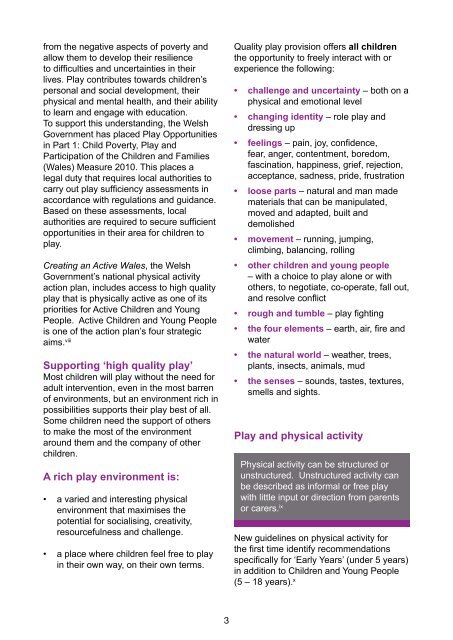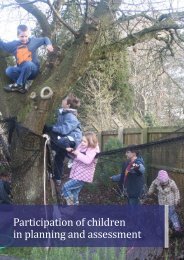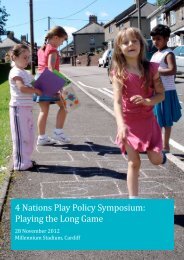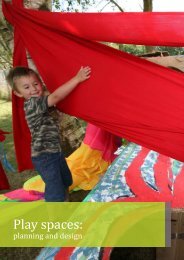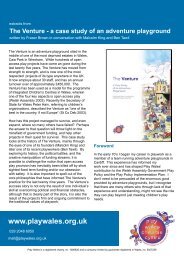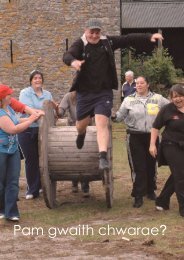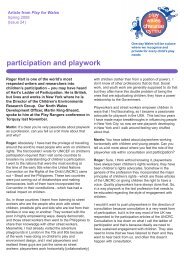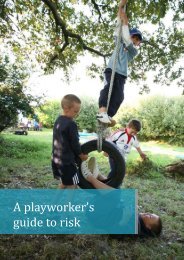health and wellbeing information sheet - Play Wales
health and wellbeing information sheet - Play Wales
health and wellbeing information sheet - Play Wales
You also want an ePaper? Increase the reach of your titles
YUMPU automatically turns print PDFs into web optimized ePapers that Google loves.
from the negative aspects of poverty <strong>and</strong><br />
allow them to develop their resilience<br />
to difficulties <strong>and</strong> uncertainties in their<br />
lives. <strong>Play</strong> contributes towards children’s<br />
personal <strong>and</strong> social development, their<br />
physical <strong>and</strong> mental <strong>health</strong>, <strong>and</strong> their ability<br />
to learn <strong>and</strong> engage with education.<br />
To support this underst<strong>and</strong>ing, the Welsh<br />
Government has placed <strong>Play</strong> Opportunities<br />
in Part 1: Child Poverty, <strong>Play</strong> <strong>and</strong><br />
Participation of the Children <strong>and</strong> Families<br />
(<strong>Wales</strong>) Measure 2010. This places a<br />
legal duty that requires local authorities to<br />
carry out play sufficiency assessments in<br />
accordance with regulations <strong>and</strong> guidance.<br />
Based on these assessments, local<br />
authorities are required to secure sufficient<br />
opportunities in their area for children to<br />
play.<br />
Creating an Active <strong>Wales</strong>, the Welsh<br />
Government’s national physical activity<br />
action plan, includes access to high quality<br />
play that is physically active as one of its<br />
priorities for Active Children <strong>and</strong> Young<br />
People. Active Children <strong>and</strong> Young People<br />
is one of the action plan’s four strategic<br />
aims. viii<br />
Supporting ‘high quality play’<br />
Most children will play without the need for<br />
adult intervention, even in the most barren<br />
of environments, but an environment rich in<br />
possibilities supports their play best of all.<br />
Some children need the support of others<br />
to make the most of the environment<br />
around them <strong>and</strong> the company of other<br />
children.<br />
A rich play environment is:<br />
• a varied <strong>and</strong> interesting physical<br />
environment that maximises the<br />
potential for socialising, creativity,<br />
resourcefulness <strong>and</strong> challenge.<br />
• a place where children feel free to play<br />
in their own way, on their own terms.<br />
Quality play provision offers all children<br />
the opportunity to freely interact with or<br />
experience the following:<br />
• challenge <strong>and</strong> uncertainty – both on a<br />
physical <strong>and</strong> emotional level<br />
• changing identity – role play <strong>and</strong><br />
dressing up<br />
• feelings – pain, joy, confidence,<br />
fear, anger, contentment, boredom,<br />
fascination, happiness, grief, rejection,<br />
acceptance, sadness, pride, frustration<br />
• loose parts – natural <strong>and</strong> man made<br />
materials that can be manipulated,<br />
moved <strong>and</strong> adapted, built <strong>and</strong><br />
demolished<br />
• movement – running, jumping,<br />
climbing, balancing, rolling<br />
• other children <strong>and</strong> young people<br />
– with a choice to play alone or with<br />
others, to negotiate, co-operate, fall out,<br />
<strong>and</strong> resolve conflict<br />
• rough <strong>and</strong> tumble – play fighting<br />
• the four elements – earth, air, fire <strong>and</strong><br />
water<br />
• the natural world – weather, trees,<br />
plants, insects, animals, mud<br />
• the senses – sounds, tastes, textures,<br />
smells <strong>and</strong> sights.<br />
<strong>Play</strong> <strong>and</strong> physical activity<br />
Physical activity can be structured or<br />
unstructured. Unstructured activity can<br />
be described as informal or free play<br />
with little input or direction from parents<br />
or carers. ix<br />
New guidelines on physical activity for<br />
the first time identify recommendations<br />
specifically for ‘Early Years’ (under 5 years)<br />
in addition to Children <strong>and</strong> Young People<br />
(5 – 18 years). x<br />
3


